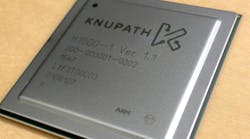Former NASA Chief Reveals Brain-Like Chip Venture
One of the lesser-known projects being pursued by the National Aeronautics and Space Administration is the development of software that learns automatically to find patterns in scientific data. Now, the project could get its computer hardware from an oddly familiar source: the agency’s former chief, Dan Goldin, who founded a startup making chips to better handle those calculations.
The company, KnuEdge, has modeled its computer chip on the human brain in an attempt to increase the speed of programs that fall under the umbrella of machine learning. The new chip could be plugged into data centers to teach itself such jobs as sorting images, understanding language, and following trends in streams of data.
Goldin founded the company in 2005, keeping its operations secret until he revealed the new chip on Monday morning, along with voice recognition software that excels in noisy environments. Over the last 10 years, he has supervised the slow process of building the new chip from scratch.
“We are not about incremental technology,” said Goldin, who serves as the chief executive of KnuEdge. “We were swinging for the fences from the very beginning.”
Most companies—ranging from startups to internet giants like Amazon and Facebook—are running artificial intelligence on standard hardware, like Intel computers and Nvidia graphics chips. Others, however, are making chips with entirely new designs, guided by the view that traditional chips are not efficient enough for the intensive calculations of machine learning.
Several startups, including Nervana Systems and Minds.ai, are using the brain as the template for new chips that enhance cloud services related to machine learning. Memory chipmakers like General Vision have found ways to interweave memory and processors into analogs for the brain’s neurons and synapses. Even Google has bolstered its data centers with custom chips for machine learning that work in tandem with Nvidia’s GPUs.
Traditional CPUs are very efficient at things like crunching numbers, but can struggle under the torrent of data contained in images or language. When it comes to finding patterns in data, these chips pale in comparison to graphics chips, which contain up to thousands of processing cores that run simple tasks in parallel.
Neuromorphic chips are similar to graphics chips, but have been designed without unnecessary parts that constrain their overall speed and efficiency. GPUs were originally developed for rendering graphics in video games, not for machine learning.
The development of chips inspired by the brain is partly being spurred by efforts to study and simulate the brain’s activity. Micron’s Automata Processor, for instance, is designed to train machine learning software on huge sets of genetic data. IBM’s True North is being used to monitor neural signals in the human brain to better predict when people will have epileptic seizures.
Goldin’s motivation to form the new venture stems from his own study of the brain. After serving as the space agency’s chief from 1992 to 2001, he studied under the wing of the neuroscientist Gerald Edelman, a Nobel laureate for his work on the immune system.
The new chip, nicknamed Hermosa, contains 256 processing cores, which act like the neurons in the human brain. The chip is an application-specific integrated circuit and can be linked together in groups as large as 512,000 devices. The neurons are connected by the connective tissue of an associated routing technology, Lambda Fabric, which ferries data between cores, processors, boards, and servers at extremely high speeds.
Each of the neurons can work on a different program, according to Pat Patla, senior vice president and general manager of KnuPath, the business unit making the new chip. The routing technology can select paths between the chip’s cores based on how efficiently they travel through the chip. That mirrors the way in which neurons in the human brain become more sensitive to each other depending on how constructively they work together.
Steve Cumings, KnuEdge’s chief marketing officer, said that the chip's other major feature is handling sparse matrix data. This class of data has fewer distinct features than so-called dense matrix data, which contain many complex numerical features that take longer for software to churn through.
Cumings did not share any customers that are currently using the chip. He said, however, that the company has already generated $20 million in revenue from partnerships in industries like banking, healthcare, and insurance.
Thus far, KnuEdge has received $100 million in private investments. Cumings said that he expected a public funding round to get underway later this year. That could be around the same time that KnuEdge begins selling boards based on the new chip, Cumings said.
Looking for parts? Go to SourceESB.

